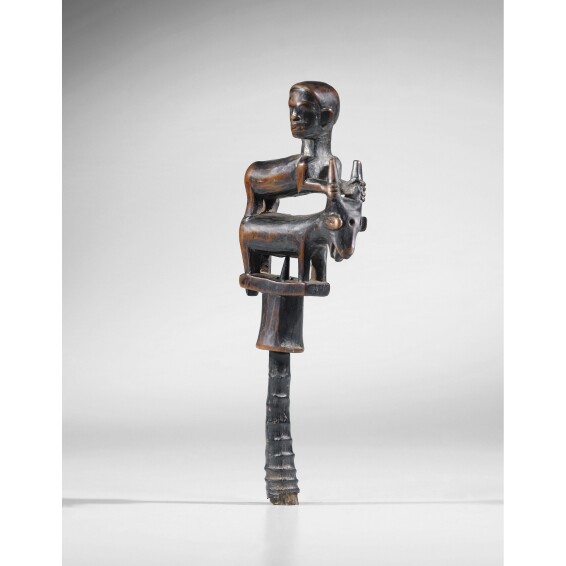- 1
Sifflet, Vili, République Démocratique du Congo
Description
- Vili
- Sifflet
- haut. 12 cm sans la corne
- 4 2/3 in
Provenance
Collection Léonce & Pierre Guerre, Marseille, n° 65
Collection Alain et Christine Vidal-Naquet, Marseille
Exhibited
Expositions:
Musée Réattu, Arles, Arts Afrique Noire, 10 avril - 30 septembre 1954
Cercle Volney, Paris, Les arts africains, juin - juillet 1955
Palais Miramar, Cannes, Première exposition rétrospective internationale des arts d'Afrique et d'Océanie, 6 juillet - 29 septembre 1957
Musée Dynamique, Dakar, L'art Nègre, Sources, Evolution Expansion, dans le cadre du Premier Festival Mondial des Arts Nègres, 1966 ; Grand Palais, Paris, 1966
Musée Cantini, Marseille, Arts Africains, mars - mai 1970
Musée d'Arts Africains, Océaniens, Amérindiens, Centre de la vieille Charité, Marseille, Pierre Guerre. Un érudit en son temps, 20 mars - 31 mai 1992
South African National Gallery, Cape Town, Art Africain dans la collection Pierre Guerre, 1997
Literature
Musée Réattu, Arts Afrique Noire, 1954 : 43, n° 140
Vérité et alii, Les arts africains, 1955 : 66, n° 270
Kamer, Première exposition rétrospective internationale des arts d'Afrique et d'Océanie, 1957, n° 226
L'Art Nègre, Sources, Evolution Expansion, 1966, n° 274
Guerre et Delange, Arts Africains, 1970, n° 130
Söderberg, "Les sifflets sculptés du bas-congo" in Arts d'Afrique Noire, n° 9, Printemps 1974 : 41, fig. 13
M.A.A.O.A., Pierre Guerre. Un érudit en son temps, 1992 : 108, n° 46
A.F.A.A., Art Africain dans la collection Pierre Guerre, 1997 : 132, n° 60
Condition
"In response to your inquiry, we are pleased to provide you with a general report of the condition of the property described above. Since we are not professional conservators or restorers, we urge you to consult with a restorer or conservator of your choice who will be better able to provide a detailed, professional report. Prospective buyers should inspect each lot to satisfy themselves as to condition and must understand that any statement made by Sotheby's is merely a subjective, qualified opinion. Prospective buyers should also refer to any Important Notices regarding this sale, which are printed in the Sale Catalogue.
NOTWITHSTANDING THIS REPORT OR ANY DISCUSSIONS CONCERNING A LOT, ALL LOTS ARE OFFERED AND SOLD AS IS" IN ACCORDANCE WITH THE CONDITIONS OF BUSINESS PRINTED IN THE SALE CATALOGUE."
Catalogue Note
Acquise par Léonce et Pierre Guerre sans son sifflet en corne d'antilope, cette miniature fut d'abord interprétée comme une "figure de cavalier, poignée de panier rituel Loango" (Réattu, 1954). En 1974, elle paraît dans l'article de l'ethno-musicoloque Bertil Söderberg sur "les sifflets sculptés du Bas-Congo" (Arts d'Afrique Noire, n° 9), rétablissant la signification de ces figurines énigmatiques "percées d'un trou vertical, conique à la base".
Selon Söderberg, la rareté de ces sifflets - associés au culte du nkisi et spécialement conçus pour la chasse -, tient de leur appartenance exclusive à des "personnes socialement éminentes, tels les hommes-médecine (banganga) et les chefs de village (1974 : 26-27). Celui-ci se distingue par son iconographie associant un personnage et un animal. Remarquable témoin de l'expressivité stylistique et gestuelle de l'art Vili, cette miniature exalte, jusque dans la dignité du visage tourné sur le côté, la maîtrise de l'animal par l'homme qui le domine. Tout en étant directement liée aux activités de la chasse pendant laquelle ce charme était utilisé, l'iconographie peut également renvoyer à l'image du nkisi maîtrisant la force d'un sorcier, nkondi (Lehuard, 1989, I : 139).
Vili whistle, Democratic Republic of the Congo
Léonce and Pierre Guerre acquired this miniature without its antelope horn whistle. First interpreted as a 'figure of a horseman, the handle from a ritual Loango basket' (Réattu, 1954), it appeared in 1966 (Dakar-Paris) as 'the end of a cane, whistle, or magical object and emblematic? of Vili'. Finally, in the correspondence provided by Pierre Guerre in his inventory book, it is described as 'part of a magic whistle representing a person mounted on the back of an antelope'. Indeed, it has been published in the article on 'the whistles carved in the Lower Congo' (in Arts d'Afrique Noire, n° 9, 1974: 41, n° 13), in which the ethno-musicologist Bertil Söderberg reinstates the significance of these rare and specific figurative miniatures from the Lower Congo, 'pierced with a vertical hole, tapered at the base'.
According to Söderberg, the rarity of these whistles – associated with the cult of nkisi and specially designed for hunting – is explained by the fact that they belonged exclusively to 'socially prominent people, such as medicine men (banganga) and the chiefs of the village (1974: 26-27). This one is distinguished, moreover, by the expression of its iconography within a dynamic composition, which represent both a character and an animal. A remarkable witness to the stylistic and gestural expressiveness of Vili art, this miniature shows how man controls and dominates the animal kingdom, demonstrated by the exalted dignity of the face turned sideways. While being directly related to the activities of the hunt during which this charm was used, the iconography may also refer to the image of a nkisi mastering the strength of a nkondi (sorcerer; cf. Lehuard, 1989, I: 139).

